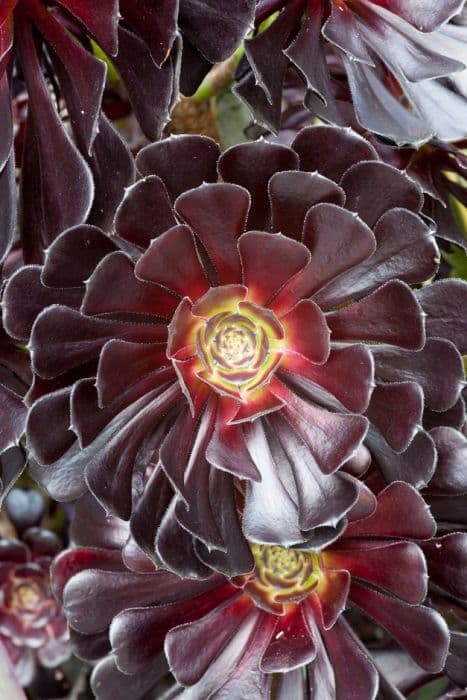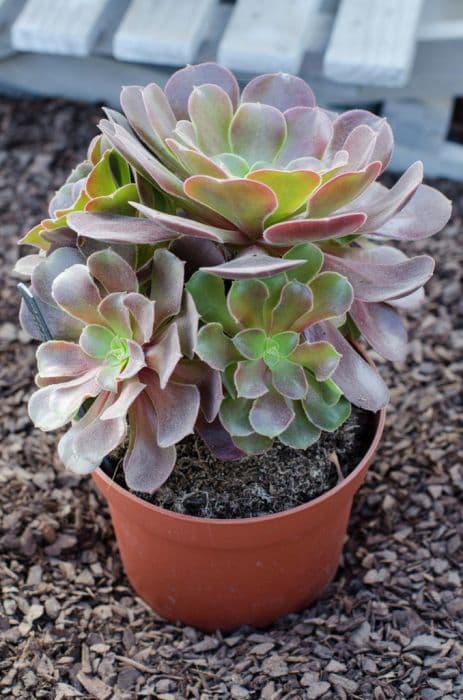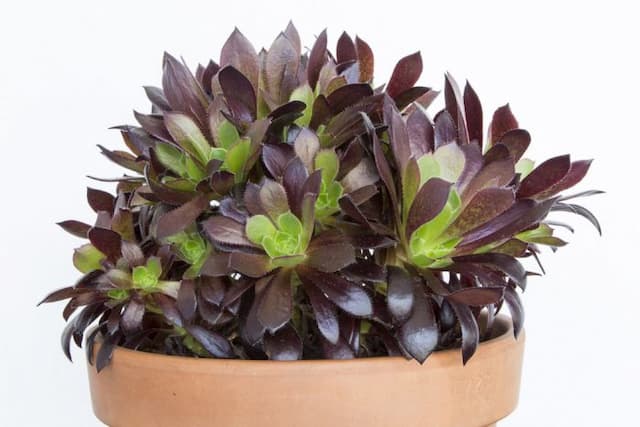Poplar-leaved stonecrop Hylotelephium populifolium

ABOUT
The plant known by its common name, the poplar-leaved stonecrop, is a succulent perennial that boasts fleshy leaves resembling those of a poplar tree. These leaves are arranged in an alternating pattern along the upright, branching stems. The foliage often has a grayish-green tone, providing a distinctive matte texture that contrasts nicely with the glossier leaves of other plants in the garden. During blooming season, clusters of tiny, star-shaped flowers burst forth in an eye-catching display. The flowers are usually of a soft hue, and they collectively create a frothy appearance atop the stems. The overall form of the poplar-leaved stonecrop is clump-forming, presenting a lush, mounded shape in the landscape. The succulent nature of its leaves and stems hints at the plant's ability to withstand dry conditions, making it a hardy addition to gardens with varying climates.
About this plant
 Names
NamesFamily
Crassulaceae
Synonyms
Poplar-Leaved Stonecrop, Poplar-Leaved Live-Forever
Common names
Sedum populifolium, Phedimus populifolius.
 Toxicity
ToxicityTo humans
Hylotelephium populifolium, commonly known as live-forever, is not typically considered toxic to humans. However, like many plants, if ingested in large quantities or by individuals with specific sensitivities, it might cause mild gastrointestinal upset, including symptoms such as nausea, vomiting, or diarrhea. Always exercise caution and keep plants out of reach of children who might inadvertently ingest plant parts.
To pets
Hylotelephium populifolium, known as live-forever, is generally not classified as toxic to pets. That being said, pets could experience mild digestive discomfort if they consume parts of the plant, with possible symptoms such as vomiting or diarrhea. As with any non-food plant, it's wise to prevent pets from eating live-forever to avoid any potential issues.
 Characteristics
CharacteristicsLife cycle
Perennials
Foliage type
Deciduous
Color of leaves
Green
Flower color
Pink
Height
1-2 feet [30-60 cm]
Spread
1-2 feet [30-60 cm]
Plant type
Succulent
Hardiness zones
3
Native area
Asia
Benefits
 General Benefits
General Benefits- Attracts Pollinators: Hylotelephium populifolium is known to attract bees and butterflies, which are essential for pollination and maintaining healthy ecosystems.
- Drought Tolerance: This plant is highly drought-resistant, making it a great choice for xeriscape gardens or areas with low water availability.
- Erosion Control: The robust root system helps stabilize soil and prevent erosion, particularly on slopes or in rocky areas.
- Seasonal Interest: It provides aesthetic value throughout the seasons with its changing foliage and blooms, enhancing the visual appeal of gardens.
- Easy to Care For: With minimal maintenance requirements, this plant is ideal for gardeners of all skill levels.
- Propagation: It can be easily propagated from cuttings or leaves, making it simple to expand your garden or share with others.
 Medical Properties
Medical PropertiesThis plant is not used for medical purposes.
 Air-purifying Qualities
Air-purifying QualitiesThis plant is not specifically known for air purifying qualities.
 Other Uses
Other Uses- Ornamental Display: Hylotelephium populifolium, commonly known as the "poplar-leaved stonecrop," is often used in garden landscapes for its attractive foliage and bloom characteristics.
- Drought-Resistant Groundcover: Because of its drought-resistant properties, poplar-leaved stonecrop is suitable for xeriscaping, reducing the need for frequent watering.
- Butterfly Garden Addition: This plant can be included in butterfly gardens to attract pollinators with its nectar-rich flowers.
- Living Roof Plantings: Its hardiness and low maintenance requirements make it a suitable choice for green roofing projects.
- Rock Garden Specimen: Owing to its tolerance for poor soil, it is commonly used in rock gardens where other plants might struggle to thrive.
- Soil Erosion Control: Poplar-leaved stonecrop's dense growth can help in stabilizing soil and preventing erosion on slopes.
- Seasonal Interest: The plant provides aesthetic interest throughout different seasons with its changing leaf colors and flowers.
- Educational Tool: It can be used to teach gardening techniques such as propagation through cuttings, as it roots easily.
- Container Gardening: It is well-suited for container gardening due to its manageable size and minimal root system.
- Photographic Subject: With its distinctive appearance, poplar-leaved stonecrop is often photographed by plant enthusiasts and used in botanical art.
Interesting Facts
 Feng Shui
Feng ShuiThe Hylotelephium, commonly known as "Live Forever," is not specifically used in Feng Shui practice.
 Zodiac Sign Compitability
Zodiac Sign CompitabilityThe Live Forever is not used in astrology practice.
 Plant Symbolism
Plant Symbolism- Resilience: As a succulent, Hylotelephium populifolium, commonly known as Poplar-leaved stonecrop, is adept at storing water, symbolizing the ability to endure and thrive in challenging conditions.
- Adaptability: This plant can grow in a wide range of climates and conditions, representing the ability to adapt and be versatile in life.
- Persistence: Poplar-leaved stonecrop is known for its tenacious growth habit, symbolizing persistence and the determination to grow despite adversities.
 Water
WaterPoplar-leaved stonecrop prefers moderate watering, as it is a drought-tolerant succulent. Water the plant deeply when the soil feels dry to the touch, approximately once a week during the active growing season. Decrease watering frequency to every few weeks during the dormant season in the fall and winter. When watering, provide enough water so that it runs out of the drainage holes of the pot, which may be around 16-32 ounces depending on pot size and soil composition. Avoid watering the leaves directly to reduce the risk of fungal diseases and make sure the soil dries out between watering sessions.
 Light
LightPoplar-leaved stonecrop thrives in bright, indirect sunlight. It can also tolerate full sun conditions, but the leaves may scorch in excessively hot climates if exposed to direct afternoon sun. The best spot for this succulent is a location where it can enjoy morning sun and afternoon shade or dappled sunlight throughout the day. Indoors, a south-facing or west-facing window with filtered light is ideal.
 Temperature
TemperaturePoplar-leaved stonecrop is hardy and adaptable to various temperature conditions but grows best in temperatures ranging between 65°F and 70°F. It can tolerate minimum temperatures down to around 30°F but should be protected from frost. This plant can withstand short periods of higher temperatures, but prolonged heat above 90°F may stress it. Ensure good air circulation to help maintain the ideal temperature around the plant.
 Pruning
PruningPruning poplar-leaved stonecrop is necessary to maintain its shape and promote healthy growth. Prune the plant in early spring by removing dead or damaged leaves and spent flower stalks. This will encourage new growth and prevent the plant from becoming too leggy. Pruning can be done annually or biannually depending on the plant's growth rate and aesthetic preference. Always use sterilized pruning tools to prevent the spread of disease.
 Cleaning
CleaningAs needed
 Soil
SoilThe best soil mix for the popularly named Poplar-leaved Stonecrop is a well-draining mix with coarse sand or perlite, combined with compost or peat moss to retain slight moisture. The ideal soil pH for Poplar-leaved Stonecrop should be slightly acidic to neutral, ranging between 6.0 and 7.0.
 Repotting
RepottingPoplar-leaved Stonecrop should be repotted every two to three years to refresh the soil and to accommodate the growing root system. Over time, the soil degrades and compacts, which can impede drainage and root growth, making periodic repotting beneficial for the plant's health.
 Humidity & Misting
Humidity & MistingPoplar-leaved Stonecrop prefers low to average humidity levels, typical of most indoor environments. A humidity level between 30-50% is ideal for this plant, and it is well suited to the average household humidity conditions.
 Suitable locations
Suitable locationsIndoor
Provide bright light, minimal water.
Outdoor
Full sun to partial shade, well-draining soil.
Hardiness zone
4-9 USDA
 Life cycle
Life cycleHylotelephium populifolium, commonly known as poplar-leaved stonecrop, starts its life cycle as a seed that germinates in spring or early summer, depending on the climate. The seed develops into a small seedling, with succulent leaves characteristic of the sedum family. As it matures, it forms a rosette base and then bolts, sending up flowering stems typically by late summer or early fall. The plant blooms with clusters of small, star-shaped flowers that are often pink or white, attracting pollinators. After blooming, the plant sets seed which are then dispersed by wind or wildlife, facilitating the spread of the species. In winter, the above-ground parts may die back, but the plant can regrow from its root system or overwintering buds when the conditions become favorable again in spring.
 Propogation
PropogationPropogation time
Spring-Early Summer
Propogation: The most popular method of propagation for Hylotelephium populifolium, commonly known as popular-leaved stonecrop, is by cuttings. This is typically done in late spring or early summer when the plant's growth is most active. To propagate, a healthy stem cutting of about 2 to 4 inches (5 to 10 cm) is taken from the plant using a clean, sharp knife or scissors. The lower leaves of the cutting are removed, and the cut end is allowed to callous over for a few days to reduce the risk of rot. The prepared cutting is then planted in well-draining soil, lightly watered, and kept in indirect sunlight until roots develop, which can take a few weeks. Once the cutting has rooted, it can be treated as a mature plant and gradually acclimatized to direct sunlight.









